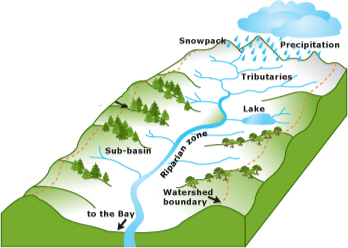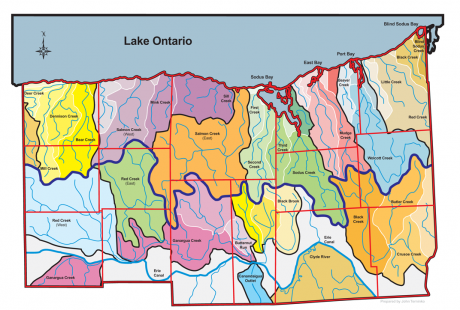 A watershed is the area that drains to a common waterway, such as a stream, lake, estuary, wetland, aquifer, or even the ocean. No matter where you live, you live in a watershed. The actions within a watershed affect the quality of water that drains through it. When it rains, pollutants from the land run off into the receiving water bodies.
A watershed is the area that drains to a common waterway, such as a stream, lake, estuary, wetland, aquifer, or even the ocean. No matter where you live, you live in a watershed. The actions within a watershed affect the quality of water that drains through it. When it rains, pollutants from the land run off into the receiving water bodies.
Wayne County crosses 3 watersheds
In the image to the right, the purple line distinguishes the boundary between drainage basins. Watersheds in the Northern half of Wayne County drain directly into Lake Ontario. This is considered a Direct Drainage Basin. The Southern half of Wayne County drains into the Erie Canal and eventually the Seneca and Oswego Rivers (part of the Seneca, Oneida, Oswego drainage basin.)
Find environmental information from USEPA for each of these watersheds:
-
- 04140101 Irondequoit-Ninemile; state(s): NY
-
- 04140201 Seneca; state(s): NY
-
- 04150200 Lake Ontario; state(s): NY
Our individual actions can directly affect water quality within a watershed. Working together using a watershed approach will help protect our nation’s water resources. Household pollutants such as fertilizers, sediment, pesticides, leaves and grass clippings, vehicle fluids, and cleaning products all have an effect on water quality.
To help protect water quality within your watershed, homeowners and citizens should:
- Use medication disposal programs for unwanted household medications, instead of pouring them down the drain. Contact your local pharmacist for the next program and location.
- Recycle un-used and outdated chemicals by taking them to a local hazardous waste collection center. This includes oil and antifreeze.
- Have your septic tank pumped out, inspected, and upgraded regularly by a certified professional.
- Test your soil before applying fertilizer. It might not need it to grow a healthy landscape.
- Use proper fertilizers and pesticides in appropriate amounts when caring for your lawn and garden. Only apply lawn fertilizer in the fall when grass needs the nutrients for strengthening root structure.
Links of Interest

